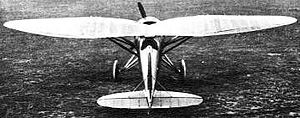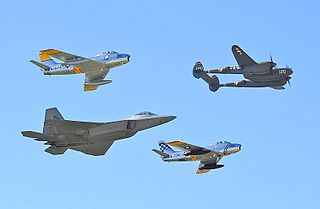
The Heinkel He 51 was a German single-seat biplane which was produced in a number of different versions. It was initially developed as a fighter, a seaplane variant and a ground-attack version were also developed. It was a development of the earlier He 49.
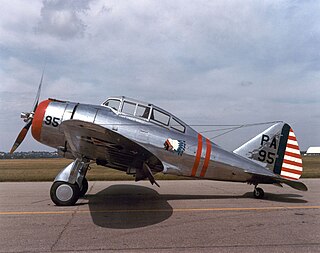
The Seversky P-35 is an American fighter aircraft built by the Seversky Aircraft Company in the late 1930s. A contemporary of the Hawker Hurricane and Messerschmitt Bf 109, the P-35 was the first single-seat fighter in United States Army Air Corps to feature all-metal construction, retractable landing gear, and an enclosed cockpit.

The Kawasaki Ki-96 was a Japanese single seat, twin-engine heavy fighter of World War II. It was intended to replace the Kawasaki Ki-45s of the Imperial Japanese Army Air Service. However, it was not adopted and only three prototypes were built.
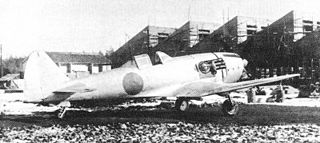
The Nakajima Ki-87 was a Japanese high-altitude fighter-interceptor of World War II. It was a single seat, exhaust-driven turbo-supercharged engined, low-wing monoplane with a conventional undercarriage.

The Gloster F.5/34 was a British fighter of the 1930s. It was a single-seat, single-engine monoplane of all-metal cantilever construction; the undercarriage was of the tailwheel type with retractable main units.

The Pfalz D.VIII was a German World War I fighter aircraft.

The Fokker D.IV was a German fighter biplane of World War I, a development of the D.I.
The Lavochkin-Gorbunov-Gudkov LaGG-1 was a Soviet fighter aircraft of World War II. Although not very successful, it formed the basis for a series of aircraft that would eventually become some of the most formidable Soviet fighters of the war.

The Gloster Sparrowhawk was a British single-seat fighter aircraft of the early 1920s. A development by Gloster Aircraft Company of the earlier Nieuport Nighthawk fighter, 50 aircraft were built by Gloster for the Imperial Japanese Navy, with a further 40 being assembled in Japan, being operated from 1921 to 1928.

The Loire 46 was a French single-seater fighter aircraft of the 1930s. A high-winged monoplane designed and built by Loire Aviation, it was purchased by the French Air Force. It was also supplied to the Spanish Republican forces during the Spanish Civil War, but was almost out of service by the outbreak of World War II.

The Daimler D.I was a German fighter aircraft of World War I. It was a conventional biplane design with a very small interplane gap - the top wing nearly touched the top of the fuselage. Power was provided by a Daimler D.III engine.

The Pfalz Dr.I was a German fighter prototype of World War I. Official interest in the potential of the triplane configuration for single-seat fighters prompted Pfalz to develop the Dr.I. It underwent initial testing in October 1917, and an initial batch of 10 aircraft were shipped to the Front and arrived in April 1918.

The Villiers II was a French two-seat fighter aircraft of the 1920s intended for operation from the Aircraft carrier Béarn of the French Navy. It was a single-engined tractor biplane with a waterproof hull in the form of a flying boat to allow the aircraft to be safely landed on water in an emergency. Two prototypes and 30 production aircraft were built, the type serving briefly with the French Navy, although never operated from an aircraft carrier.

The Macchi M.26 was an Italian flying boat fighter prototype of 1924 designed and manufactured by Macchi.

The Macchi M.71 was an Italian flying boat fighter of the 1930s designed and manufactured by Macchi.

The Macchi M.14 was an Italian fighter of 1918 designed and manufactured by Macchi. The M.14 was the first non-seaplane fighter Macchi produced, its previous fighter production having focused on flying boat fighters.

The Macchi M.6 was an Italian flying boat fighter prototype of 1917.
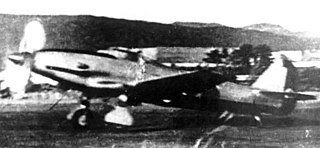
The Kawasaki Ki-64 was a one-off prototype of an experimental heavy, single seat, fighter. It had two unusual design features. First; it had two Kawasaki Ha-40 engines in tandem; one in the aircraft nose, the other behind the cockpit, both being connected by a drive shaft. This combination drove two, three-bladed, contra-rotating propellors. The second feature was the use of the wing surface as a radiator for the water-cooled engines. The aircraft first flew in December 1943. During the fifth flight, the rear engine caught fire; and while the aircraft made an emergency landing, it was damaged. The aircraft was subsequently abandoned in mid-1944 in favour of more promising projects. The airframe survived the war, and parts of the unique cooling system were sent to Wright Field for examination.

The Bernard H.52 was a French floatplane fighter aircraft of the 1930s. It was a single engine, single-seat monoplane built in the hope of being selected by the French Navy. Two prototypes were built, but no production followed.
The Roussel R-30 was a French fighter-bomber prototype of the 1930s.
